MNG81001 Management Communication: Social Media Analysis of McDonald's
VerifiedAdded on 2023/06/07
|6
|1398
|131
Report
AI Summary
This report analyzes McDonald's social media strategy, focusing on the advantages and disadvantages of its social media presence. The report discusses the importance of understanding the target audience, including both positive and negative perceptions of the brand, and the potential impact of social media on the company's image. It examines the need for a well-defined communication plan, considering timing, target audience, key messages, desired outcomes, and appropriate media. The report suggests improvements for future Twitter campaigns, emphasizing the need for innovative and engaging content to avoid past mistakes. The conclusion highlights the importance of proactive social media management for McDonald's to enhance its brand image and profitability. The report also includes references to academic sources supporting the analysis.
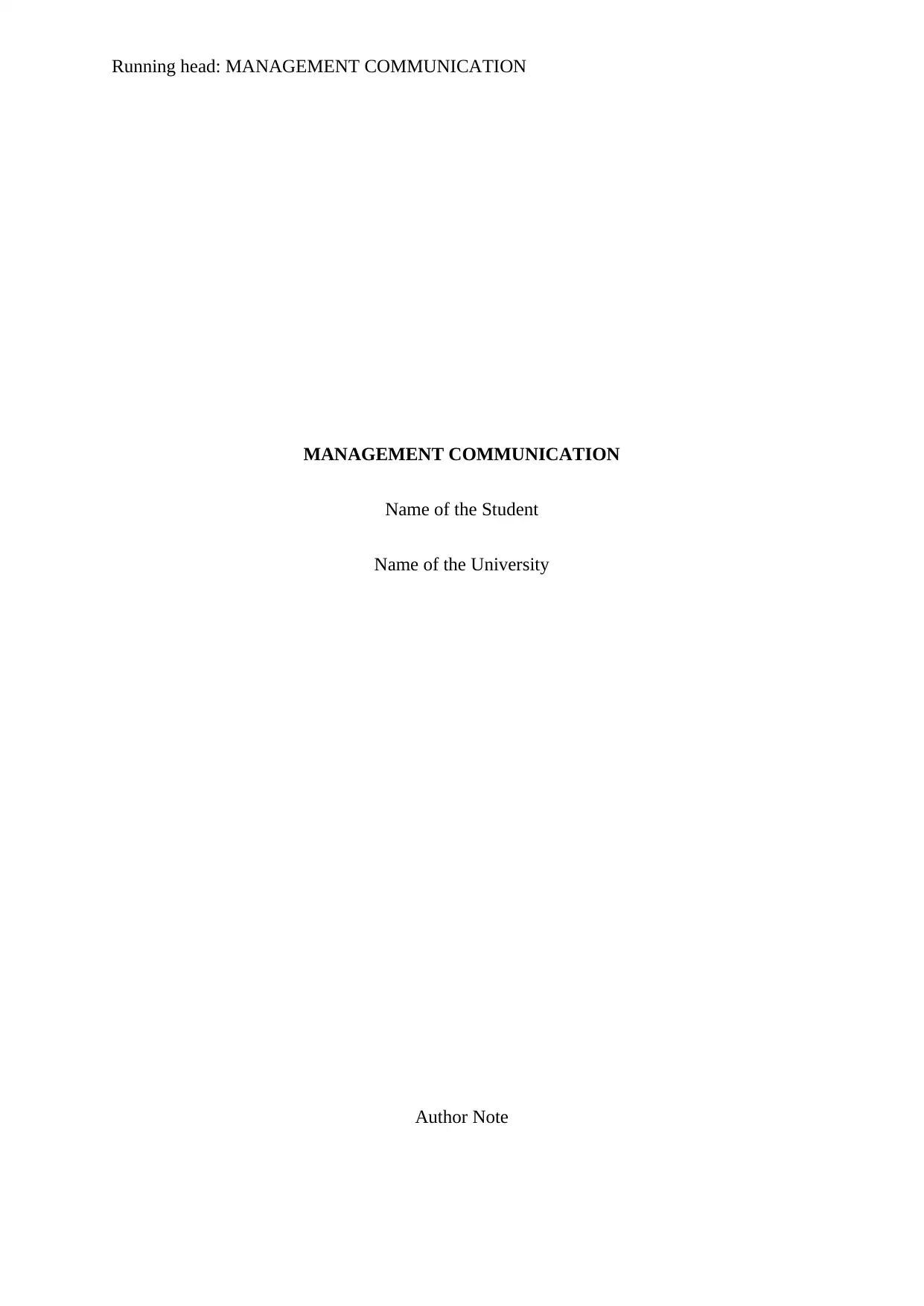
Running head: MANAGEMENT COMMUNICATION
MANAGEMENT COMMUNICATION
Name of the Student
Name of the University
Author Note
MANAGEMENT COMMUNICATION
Name of the Student
Name of the University
Author Note
Paraphrase This Document
Need a fresh take? Get an instant paraphrase of this document with our AI Paraphraser
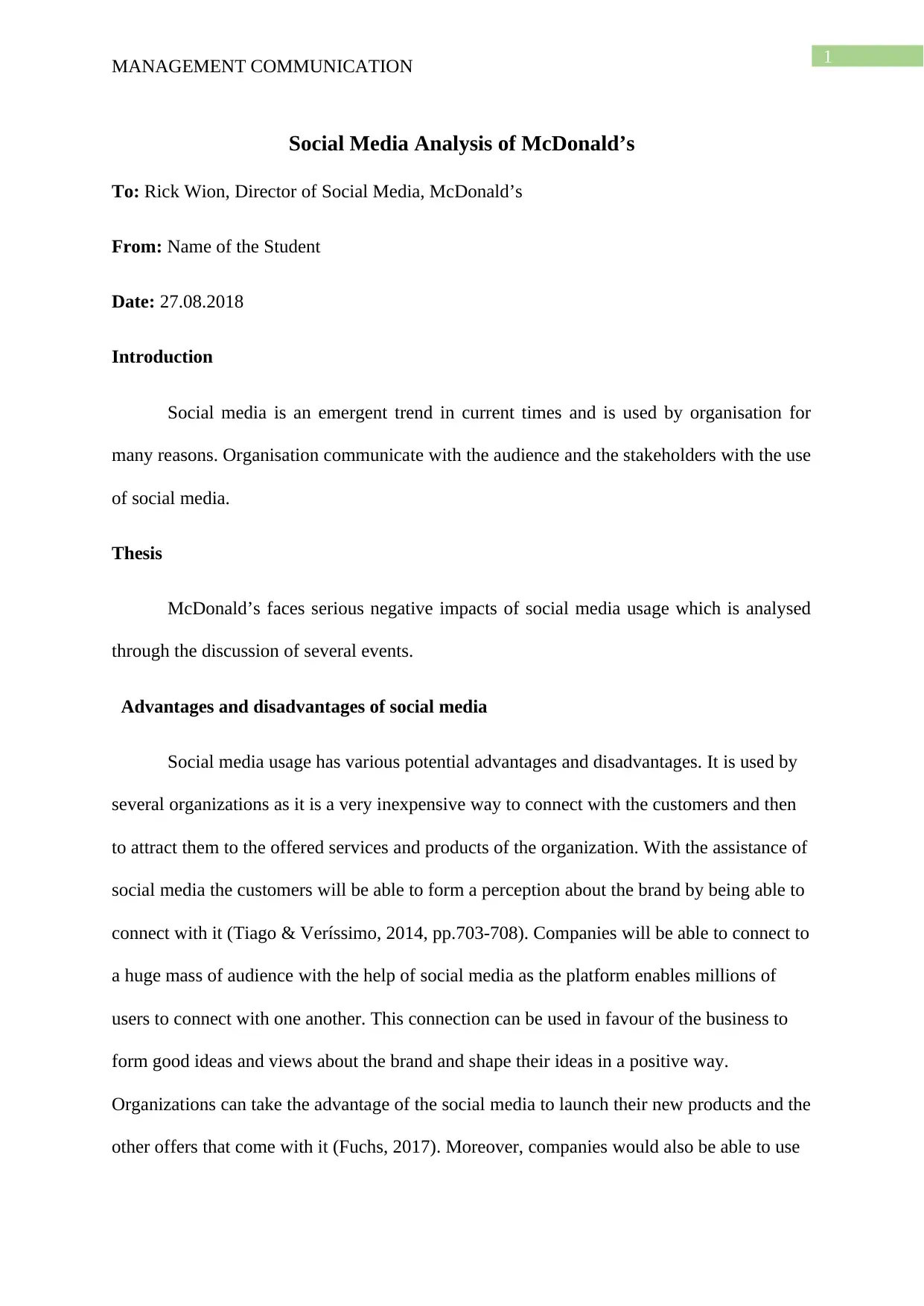
1
MANAGEMENT COMMUNICATION
Social Media Analysis of McDonald’s
To: Rick Wion, Director of Social Media, McDonald’s
From: Name of the Student
Date: 27.08.2018
Introduction
Social media is an emergent trend in current times and is used by organisation for
many reasons. Organisation communicate with the audience and the stakeholders with the use
of social media.
Thesis
McDonald’s faces serious negative impacts of social media usage which is analysed
through the discussion of several events.
Advantages and disadvantages of social media
Social media usage has various potential advantages and disadvantages. It is used by
several organizations as it is a very inexpensive way to connect with the customers and then
to attract them to the offered services and products of the organization. With the assistance of
social media the customers will be able to form a perception about the brand by being able to
connect with it (Tiago & Veríssimo, 2014, pp.703-708). Companies will be able to connect to
a huge mass of audience with the help of social media as the platform enables millions of
users to connect with one another. This connection can be used in favour of the business to
form good ideas and views about the brand and shape their ideas in a positive way.
Organizations can take the advantage of the social media to launch their new products and the
other offers that come with it (Fuchs, 2017). Moreover, companies would also be able to use
MANAGEMENT COMMUNICATION
Social Media Analysis of McDonald’s
To: Rick Wion, Director of Social Media, McDonald’s
From: Name of the Student
Date: 27.08.2018
Introduction
Social media is an emergent trend in current times and is used by organisation for
many reasons. Organisation communicate with the audience and the stakeholders with the use
of social media.
Thesis
McDonald’s faces serious negative impacts of social media usage which is analysed
through the discussion of several events.
Advantages and disadvantages of social media
Social media usage has various potential advantages and disadvantages. It is used by
several organizations as it is a very inexpensive way to connect with the customers and then
to attract them to the offered services and products of the organization. With the assistance of
social media the customers will be able to form a perception about the brand by being able to
connect with it (Tiago & Veríssimo, 2014, pp.703-708). Companies will be able to connect to
a huge mass of audience with the help of social media as the platform enables millions of
users to connect with one another. This connection can be used in favour of the business to
form good ideas and views about the brand and shape their ideas in a positive way.
Organizations can take the advantage of the social media to launch their new products and the
other offers that come with it (Fuchs, 2017). Moreover, companies would also be able to use

2
MANAGEMENT COMMUNICATION
analytic services to determine the demographics who is in reality interested in the items that
they sell or showcase. The company can get each one these benefits without having to spend
a lot of money.
However, the use of social media can have both their advantages and disadvantages.
The usage of numerous social platforms can be a disadvantage for a company as they can
become highly expensive. Companies need to be continuously engaged with their employees
to advise them regarding the sales that they do on social media (Okazaki & Taylor, 2013,
pp.56-71). The company has to give daily updates on the occurring of the company on every
social media platform. They also need to be continuously engaged with the customers and
reply on every one of their questions (Gensler et al., 2013, pp.242-256).
Audiences of McDonald’s
Before entering the scene of social media, McDonald’s have to fist have a clear
understanding about the audiences and divide the people who have a negative and a positive
view about them. Understanding these two different types of audiences well will help the
company to have a good social media tenure and will also help them to have a manageable
mechanism in case of any social media hurdle (Holt, 2016, pp.40-50). The people who are a
regular customer of McDonald’s will always have a positive outlook about the company if
they get any benefits from them. The benefits could include awards or vouchers or even
discounts for their loyalty towards the company. These are the audience who would give
positive feedbacks about the company on different social media platforms and contribute in
increasing the good name of McDonald’s.
On the other hand, there are also an audience group who are opposed to the operations
that are going on in the company. There are both people and organization who can be against
McDonald’s. Organizations such as Peoples for the Ethical Treatment of Animals (PETA)
MANAGEMENT COMMUNICATION
analytic services to determine the demographics who is in reality interested in the items that
they sell or showcase. The company can get each one these benefits without having to spend
a lot of money.
However, the use of social media can have both their advantages and disadvantages.
The usage of numerous social platforms can be a disadvantage for a company as they can
become highly expensive. Companies need to be continuously engaged with their employees
to advise them regarding the sales that they do on social media (Okazaki & Taylor, 2013,
pp.56-71). The company has to give daily updates on the occurring of the company on every
social media platform. They also need to be continuously engaged with the customers and
reply on every one of their questions (Gensler et al., 2013, pp.242-256).
Audiences of McDonald’s
Before entering the scene of social media, McDonald’s have to fist have a clear
understanding about the audiences and divide the people who have a negative and a positive
view about them. Understanding these two different types of audiences well will help the
company to have a good social media tenure and will also help them to have a manageable
mechanism in case of any social media hurdle (Holt, 2016, pp.40-50). The people who are a
regular customer of McDonald’s will always have a positive outlook about the company if
they get any benefits from them. The benefits could include awards or vouchers or even
discounts for their loyalty towards the company. These are the audience who would give
positive feedbacks about the company on different social media platforms and contribute in
increasing the good name of McDonald’s.
On the other hand, there are also an audience group who are opposed to the operations
that are going on in the company. There are both people and organization who can be against
McDonald’s. Organizations such as Peoples for the Ethical Treatment of Animals (PETA)
⊘ This is a preview!⊘
Do you want full access?
Subscribe today to unlock all pages.

Trusted by 1+ million students worldwide
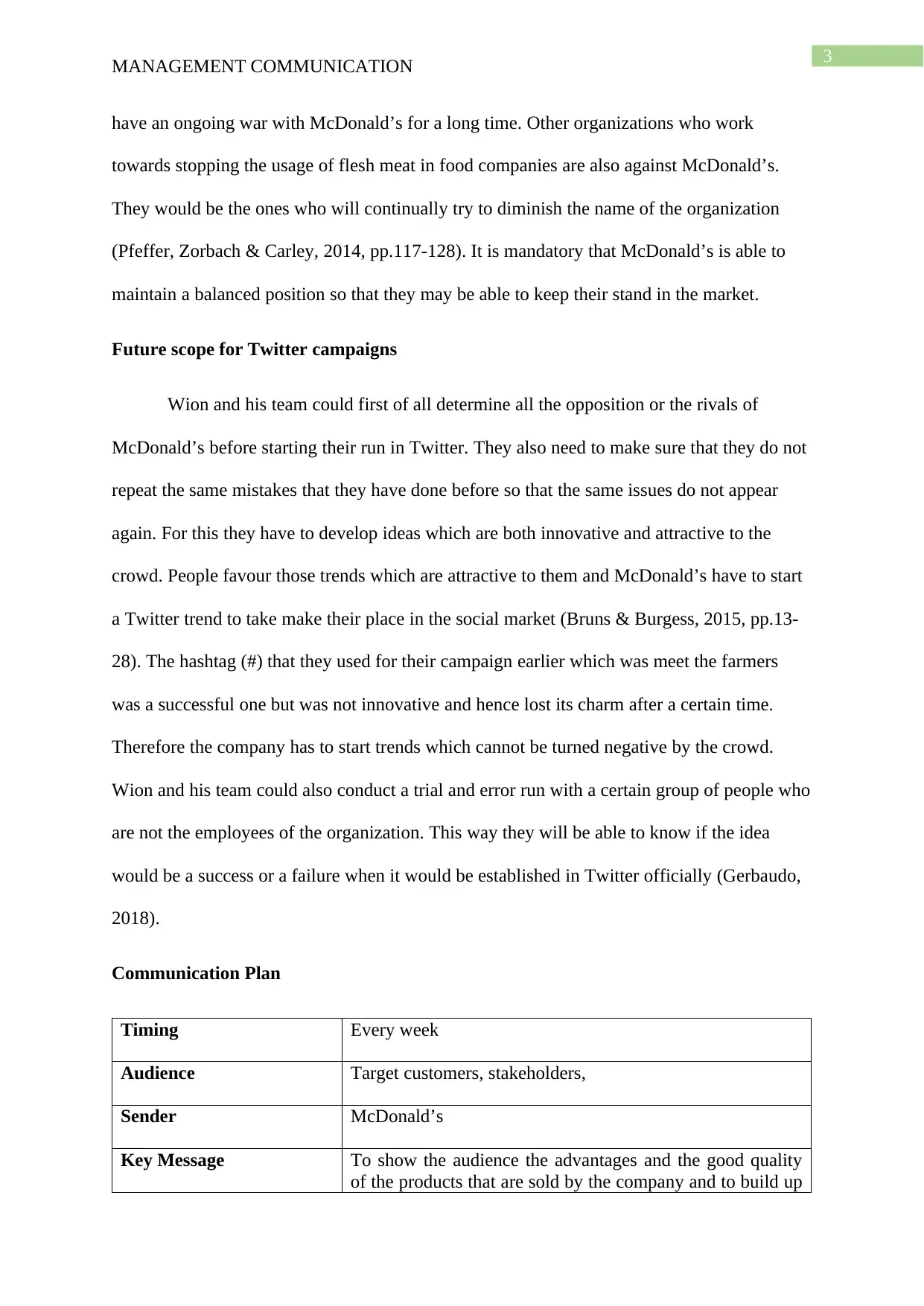
3
MANAGEMENT COMMUNICATION
have an ongoing war with McDonald’s for a long time. Other organizations who work
towards stopping the usage of flesh meat in food companies are also against McDonald’s.
They would be the ones who will continually try to diminish the name of the organization
(Pfeffer, Zorbach & Carley, 2014, pp.117-128). It is mandatory that McDonald’s is able to
maintain a balanced position so that they may be able to keep their stand in the market.
Future scope for Twitter campaigns
Wion and his team could first of all determine all the opposition or the rivals of
McDonald’s before starting their run in Twitter. They also need to make sure that they do not
repeat the same mistakes that they have done before so that the same issues do not appear
again. For this they have to develop ideas which are both innovative and attractive to the
crowd. People favour those trends which are attractive to them and McDonald’s have to start
a Twitter trend to take make their place in the social market (Bruns & Burgess, 2015, pp.13-
28). The hashtag (#) that they used for their campaign earlier which was meet the farmers
was a successful one but was not innovative and hence lost its charm after a certain time.
Therefore the company has to start trends which cannot be turned negative by the crowd.
Wion and his team could also conduct a trial and error run with a certain group of people who
are not the employees of the organization. This way they will be able to know if the idea
would be a success or a failure when it would be established in Twitter officially (Gerbaudo,
2018).
Communication Plan
Timing Every week
Audience Target customers, stakeholders,
Sender McDonald’s
Key Message To show the audience the advantages and the good quality
of the products that are sold by the company and to build up
MANAGEMENT COMMUNICATION
have an ongoing war with McDonald’s for a long time. Other organizations who work
towards stopping the usage of flesh meat in food companies are also against McDonald’s.
They would be the ones who will continually try to diminish the name of the organization
(Pfeffer, Zorbach & Carley, 2014, pp.117-128). It is mandatory that McDonald’s is able to
maintain a balanced position so that they may be able to keep their stand in the market.
Future scope for Twitter campaigns
Wion and his team could first of all determine all the opposition or the rivals of
McDonald’s before starting their run in Twitter. They also need to make sure that they do not
repeat the same mistakes that they have done before so that the same issues do not appear
again. For this they have to develop ideas which are both innovative and attractive to the
crowd. People favour those trends which are attractive to them and McDonald’s have to start
a Twitter trend to take make their place in the social market (Bruns & Burgess, 2015, pp.13-
28). The hashtag (#) that they used for their campaign earlier which was meet the farmers
was a successful one but was not innovative and hence lost its charm after a certain time.
Therefore the company has to start trends which cannot be turned negative by the crowd.
Wion and his team could also conduct a trial and error run with a certain group of people who
are not the employees of the organization. This way they will be able to know if the idea
would be a success or a failure when it would be established in Twitter officially (Gerbaudo,
2018).
Communication Plan
Timing Every week
Audience Target customers, stakeholders,
Sender McDonald’s
Key Message To show the audience the advantages and the good quality
of the products that are sold by the company and to build up
Paraphrase This Document
Need a fresh take? Get an instant paraphrase of this document with our AI Paraphraser
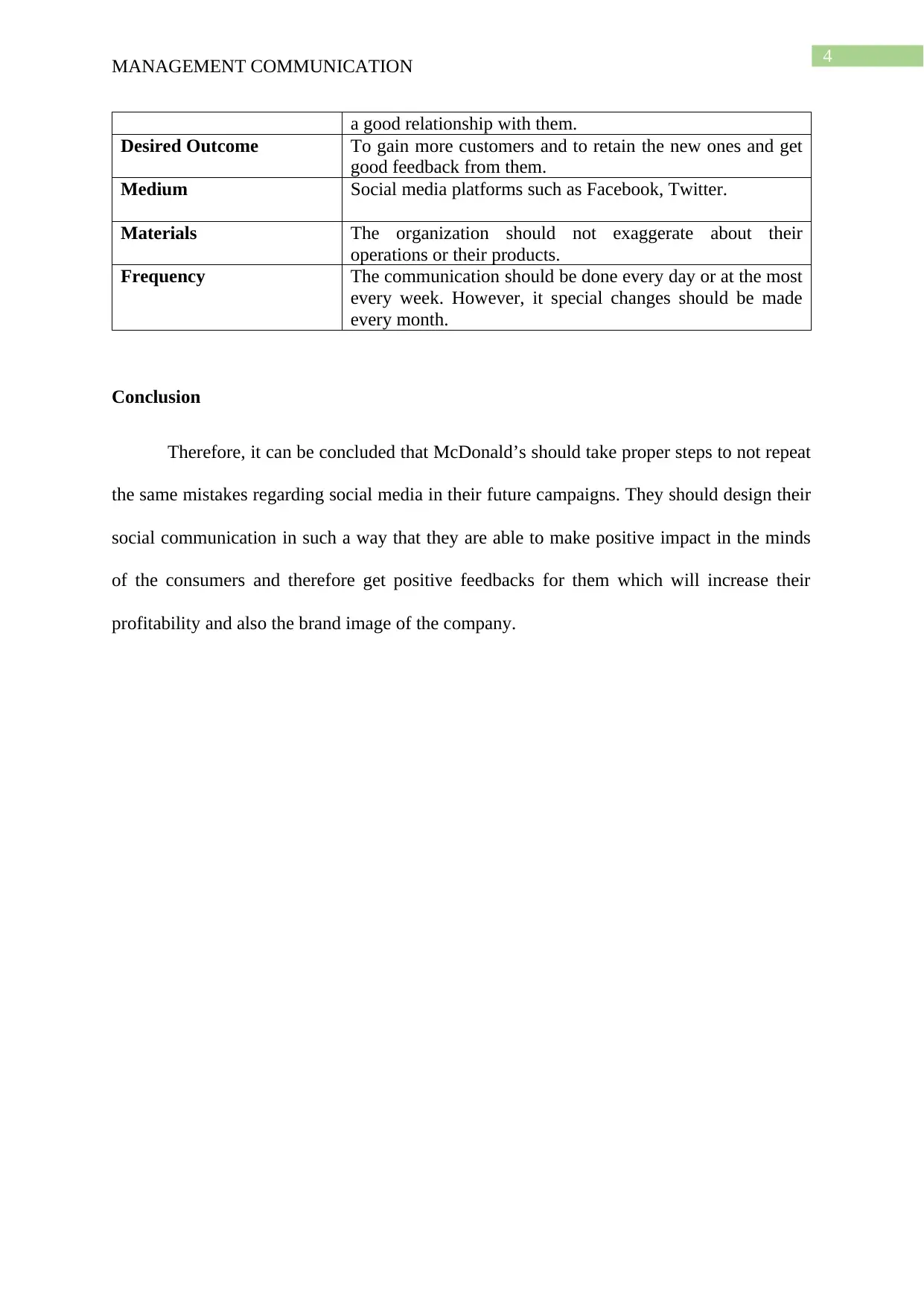
4
MANAGEMENT COMMUNICATION
a good relationship with them.
Desired Outcome To gain more customers and to retain the new ones and get
good feedback from them.
Medium Social media platforms such as Facebook, Twitter.
Materials The organization should not exaggerate about their
operations or their products.
Frequency The communication should be done every day or at the most
every week. However, it special changes should be made
every month.
Conclusion
Therefore, it can be concluded that McDonald’s should take proper steps to not repeat
the same mistakes regarding social media in their future campaigns. They should design their
social communication in such a way that they are able to make positive impact in the minds
of the consumers and therefore get positive feedbacks for them which will increase their
profitability and also the brand image of the company.
MANAGEMENT COMMUNICATION
a good relationship with them.
Desired Outcome To gain more customers and to retain the new ones and get
good feedback from them.
Medium Social media platforms such as Facebook, Twitter.
Materials The organization should not exaggerate about their
operations or their products.
Frequency The communication should be done every day or at the most
every week. However, it special changes should be made
every month.
Conclusion
Therefore, it can be concluded that McDonald’s should take proper steps to not repeat
the same mistakes regarding social media in their future campaigns. They should design their
social communication in such a way that they are able to make positive impact in the minds
of the consumers and therefore get positive feedbacks for them which will increase their
profitability and also the brand image of the company.
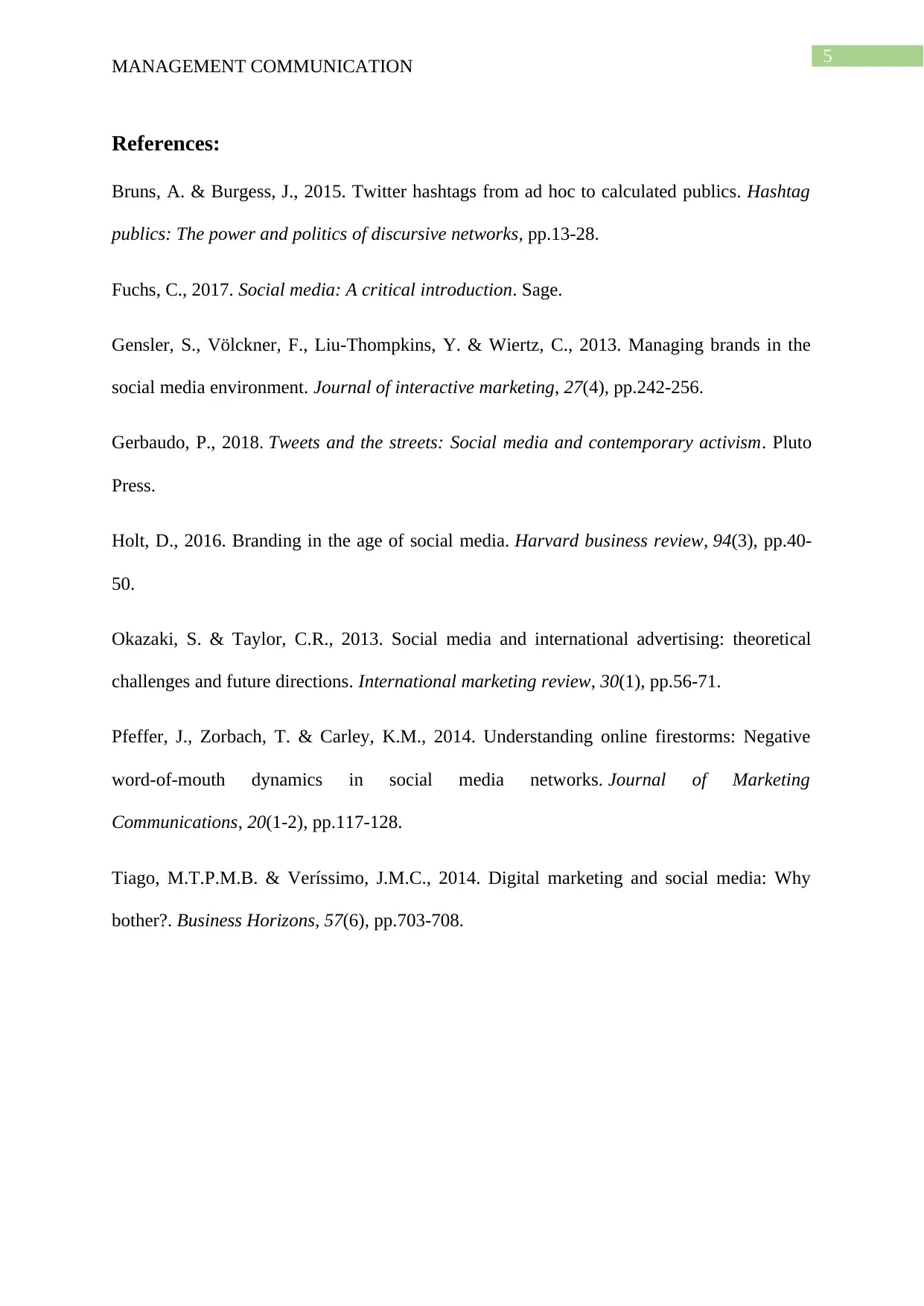
5
MANAGEMENT COMMUNICATION
References:
Bruns, A. & Burgess, J., 2015. Twitter hashtags from ad hoc to calculated publics. Hashtag
publics: The power and politics of discursive networks, pp.13-28.
Fuchs, C., 2017. Social media: A critical introduction. Sage.
Gensler, S., Völckner, F., Liu-Thompkins, Y. & Wiertz, C., 2013. Managing brands in the
social media environment. Journal of interactive marketing, 27(4), pp.242-256.
Gerbaudo, P., 2018. Tweets and the streets: Social media and contemporary activism. Pluto
Press.
Holt, D., 2016. Branding in the age of social media. Harvard business review, 94(3), pp.40-
50.
Okazaki, S. & Taylor, C.R., 2013. Social media and international advertising: theoretical
challenges and future directions. International marketing review, 30(1), pp.56-71.
Pfeffer, J., Zorbach, T. & Carley, K.M., 2014. Understanding online firestorms: Negative
word-of-mouth dynamics in social media networks. Journal of Marketing
Communications, 20(1-2), pp.117-128.
Tiago, M.T.P.M.B. & Veríssimo, J.M.C., 2014. Digital marketing and social media: Why
bother?. Business Horizons, 57(6), pp.703-708.
MANAGEMENT COMMUNICATION
References:
Bruns, A. & Burgess, J., 2015. Twitter hashtags from ad hoc to calculated publics. Hashtag
publics: The power and politics of discursive networks, pp.13-28.
Fuchs, C., 2017. Social media: A critical introduction. Sage.
Gensler, S., Völckner, F., Liu-Thompkins, Y. & Wiertz, C., 2013. Managing brands in the
social media environment. Journal of interactive marketing, 27(4), pp.242-256.
Gerbaudo, P., 2018. Tweets and the streets: Social media and contemporary activism. Pluto
Press.
Holt, D., 2016. Branding in the age of social media. Harvard business review, 94(3), pp.40-
50.
Okazaki, S. & Taylor, C.R., 2013. Social media and international advertising: theoretical
challenges and future directions. International marketing review, 30(1), pp.56-71.
Pfeffer, J., Zorbach, T. & Carley, K.M., 2014. Understanding online firestorms: Negative
word-of-mouth dynamics in social media networks. Journal of Marketing
Communications, 20(1-2), pp.117-128.
Tiago, M.T.P.M.B. & Veríssimo, J.M.C., 2014. Digital marketing and social media: Why
bother?. Business Horizons, 57(6), pp.703-708.
⊘ This is a preview!⊘
Do you want full access?
Subscribe today to unlock all pages.

Trusted by 1+ million students worldwide
1 out of 6
Related Documents
Your All-in-One AI-Powered Toolkit for Academic Success.
+13062052269
info@desklib.com
Available 24*7 on WhatsApp / Email
![[object Object]](/_next/static/media/star-bottom.7253800d.svg)
Unlock your academic potential
Copyright © 2020–2025 A2Z Services. All Rights Reserved. Developed and managed by ZUCOL.



